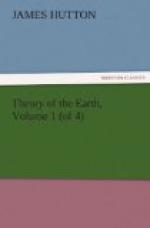But besides that negative argument concerning the insolubility of crystal, by which the erroneous suppositions of naturalists are to be rejected, crystal in general is found regularly concreted in the cavities of the most solid rock, in the heart of the closest agate, and in the midst of granite mountains. But these masses of granite were formed by fusion; I hope that I shall give the most satisfactory proof of that truth: Consequently, here at least there is no occasion for the action of water in dissolving siliceous substances in one place, in order to concrete and crystallise it in another.
In these cavities of the solid granite rock, where crystal is found regularly shooting from a basis which is the internal surface of the cavity, we find the other constituent substances of the granite also crystallised. I have those small cavities, in this rock, from the island of Arran, containing crystal, felt-spar, and mica, all crystallised in the same cavity[34]. But this is nothing to the druzen or crystalline concretions, which are found in a similar manner among metallic and mineral substances in the veins and mines; there, every species of mineral and metallic substance, with every variety of mixture and composition, are found both concreted and crystallised together in every imaginable shape and situation.
[Note 34: The Chevalier Dolomieu makes the following observation. Journal de Physique, Juillet 1791.
“J’ai ete etonne de trouver au centre d’un enorme massif de granit, que l’on avoit ouvert avec la poudre pour pratiquer un chemin, des morceaux, gros comme le poing et au dessous, de spath calcaire blanc, tres-effervescent, en grandes ecailles, ou lames entrecroisees. Il n’occupoit point des cavites particulieres, il n’y paroissoit le produit d’une infiltration qui auroit rempli des cavites, mais il etoit incorpore avec les feld-spath, le mica, et le quartz, faissoit masse avec eux, et ne pouvoit se rompre sans les entrainer avec lui.”
This great naturalist is convinced that the spar had not been here introduced by infiltration, although that is the very method which he employs to form concretions, not only of spar but of crystal, zeolite, and pyrites, in the closest cavities of the most solid rocks of basaltes. These four substances in this stone were so mixed together that nothing but the fusion of the whole mass could explain the state in which they appeared; but, thinking that such a supposition could not be allowed, this naturalist, like a man of science when his data fail, leaves the matter without any interpretation of his own. This however is what he has not done in the case of basaltes, or that which he mistakes for proper lavas, as I shall have occasion to show.]
Here is an infinite operation, but an operation which is easily performed by the natural arrangement of substances acting freely in a fluid state, and concreting together, each substance, whether more simple or more compound, directing itself by its internal principle of attraction, and affecting mechanically those that are concreting around it.




